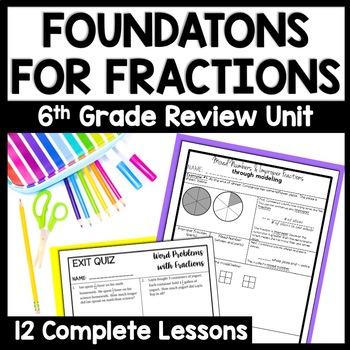6th Grade Fraction Review Unit: Middle School Math Intervention Worksheets
- Various file types
What educators are saying
Products in this Bundle (12)
showing 1-5 of 12 products
Bonus
Description
Are you a sixth grade mathteacher battling learning loss from previous grade levels? Then this 6th Grade Fraction Review Unit is for you! Over 100 pages of middle school or 6th grade math intervention worksheets include everything your students need to be successful in sixth grade math and beyond.
Bottom line: Sixth grade math content hinges on fraction understanding. Don’t spend the whole school year wishing you’d remediated fractions from the beginning! Grab this bundle today!
Teaching in a post-pandemic world is hard. Our students are further behind than ever before. You may hear yourself saying- "How am I supposed to teach 6th grade math? My students need 3rd, 4th, and 5th grade math!"
You are not alone! You can address these learning gaps and still maintain a high bar for sixth grade content.
What's included?
- Overview & Implementation Guide
- Fraction Diagnostic Assessment (Digital & Printable)
- Reteach Planning Guide
- 12-Days of Complete Lesson Packets
- Over 100 pages of ready-to-use lesson material!
Digital Diagnostic:
- In Google Forms
- Easy Auto-Grade
- 100% Editable
12 Complete Lesson Packets:
- Lesson 1: What is a Fraction?
- Lesson 2: Equivalent Fractions
- Lesson 3: Simplifying Fractions
- Lesson 4: Comparing & Ordering Fractions through Estimation
- Lesson 5: Comparing Fractions through Finding a Common Denominator
- Lesson 6: Understanding Mixed Numbers & Improper Fractions
- Lesson 7: Converting Mixed Numbers to Improper Fractions
- Lesson 8: Converting Improper Fractions to Mixed Numbers
- Lesson 9: Adding & Subtracting Unlike Fractions
- Lesson 10: Adding & Subtracting Unlike Mixed Numbers
- Lesson 11: Multiplying Fractions & Mixed Numbers
- Lesson 12: Fraction Word Problems: Addition, Subtraction, & Multiplication
WANT TO TRY BEFORE YOU BUY?
FREE Adding & Subtracting Mixed Numbers Lesson
Each Complete Lesson Packet Includes:
✔Instructional Guide
✔Teacher-Lead Example Problems
✔Partner Practice
✔3-Page Independent Practice
✔Challenge Page for Early Finishers
✔Exit Quiz
✔Detailed Answer Keys
The reality is that if we don't address the learning gaps in our classroom, our students will feel disinvested and fall even further behind. Launching directly into 6th grade content will leave everyone feeling frustrated and you will waste more time down the road trying to reteach everything. Better to address the problem head-on from the beginning of the year!
Lessons are designed to be used whole group or in a small group setting, depending on the needs of your students.
Start your year off on the right foot. Give your students the skills and confidence they need to have a successful year in your sixth grade math class!
Check out my other 6th Grade Review Unit:
FOUNDATIONS FOR SIXTH GRADE: WHOLE NUMBER OPERATIONS
Hot TpT Tips:
- Click the green star to follow me! Find out about new products at 50% off for the first 48 hours.
- Get store credit for future purchases by leaving a review for this one! Go to "My Purchases" and under the title of each purchase you will see a "Provide Feedback" button. Feedback makes a huge difference to sellers.
Happy Teaching!





